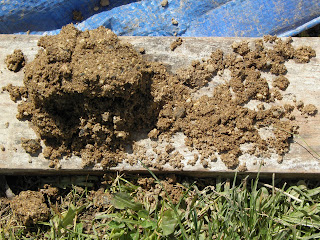
Here it is, the first pizza. A simple margarita style. I tried to take it out too soon and the back got scrunched a little (that is what I am picking up here). But, once it was properly cooked it came out fine. I think the oven floor was a bit too hot though as the bottom was scorched. No, make that, charred. I had set a thermocouple on the oven floor just prior to cooking and it registered 600 degrees F on my digital thermometer. I think the actual hearth temperature was probably considerably hotter though since I had the fire right on top of it four a couple of hours before moving it back to bake the pizza.
Speaking of fire, this was the second day of firing. I started, I am guessing, around 11:00 am with small fires. As the day progressed I built larger fires, mostly because I was tired of trying to split the oak that we had in our wood pile (very hard) and started using the smaller pieces of wood (about 3" in diameter). At one point I formed some clay around my thermocouple and stuck it in the fire. It was well above 1,000 degrees F. The ambient temperature inside the oven stayed around 400 degrees most of the day. I think most of the energy went to drying the clay. Around 4:00 the clay stopped steaming and the oven temperature started raising.
At this point I went inside and took out two portions of the pizza dough that I had made the day before and had raising in the
refrigerator. I will post the recipe later. We put the first pizza on at 6:00 pm.







































